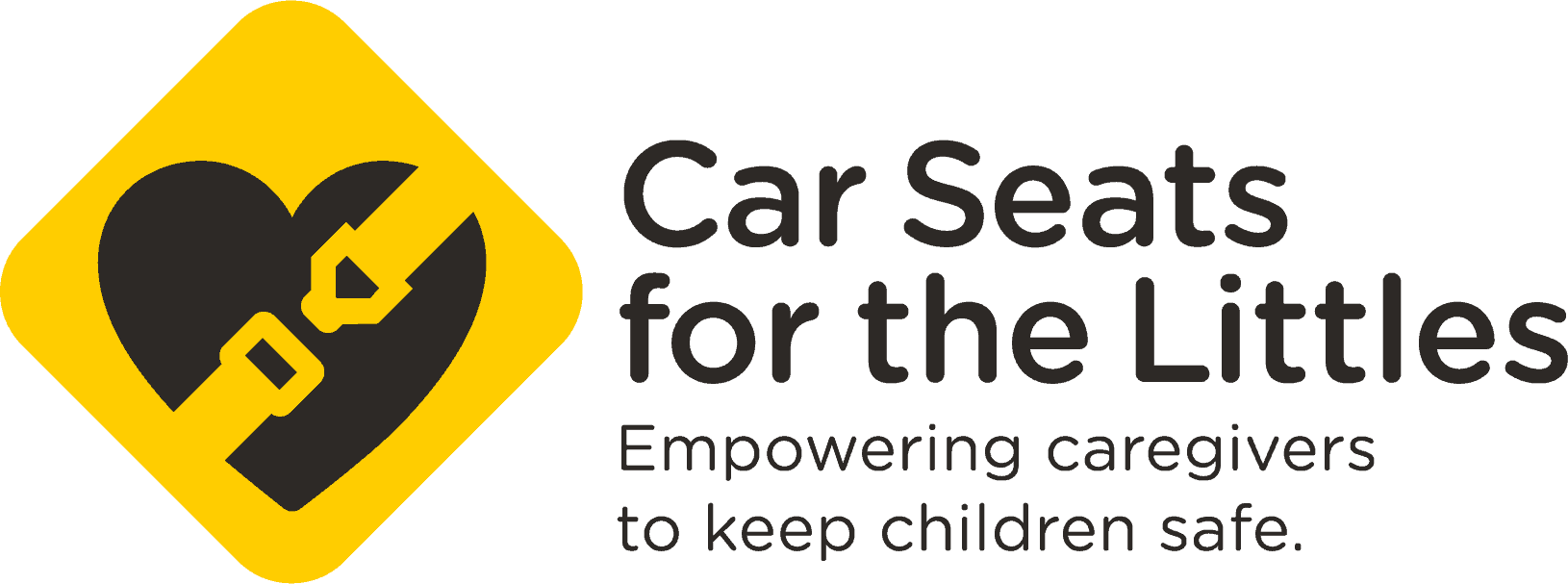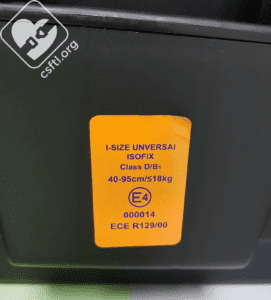The car seat world is constantly changing, we work hard to keep up on the latest and greatest so we can help caregivers at every step in the process. Unfortunately, we’re seeing a rise in something new and troubling — counterfeit car seats. They look and act like car seats that meet or exceed the FMVSS 213 federal safety standard but in the end, many families are unknowingly purchasing these car seats that are not safe or legal to use.
We’ve put together a list (with examples!) of things a safe and legal to use car seat will have and how to determine if the car seat you bought can be used. We also help you figure out what to do if you’ve unknowingly purchased one of these seats.
Things to Look for
#1: Informational Safety Labels
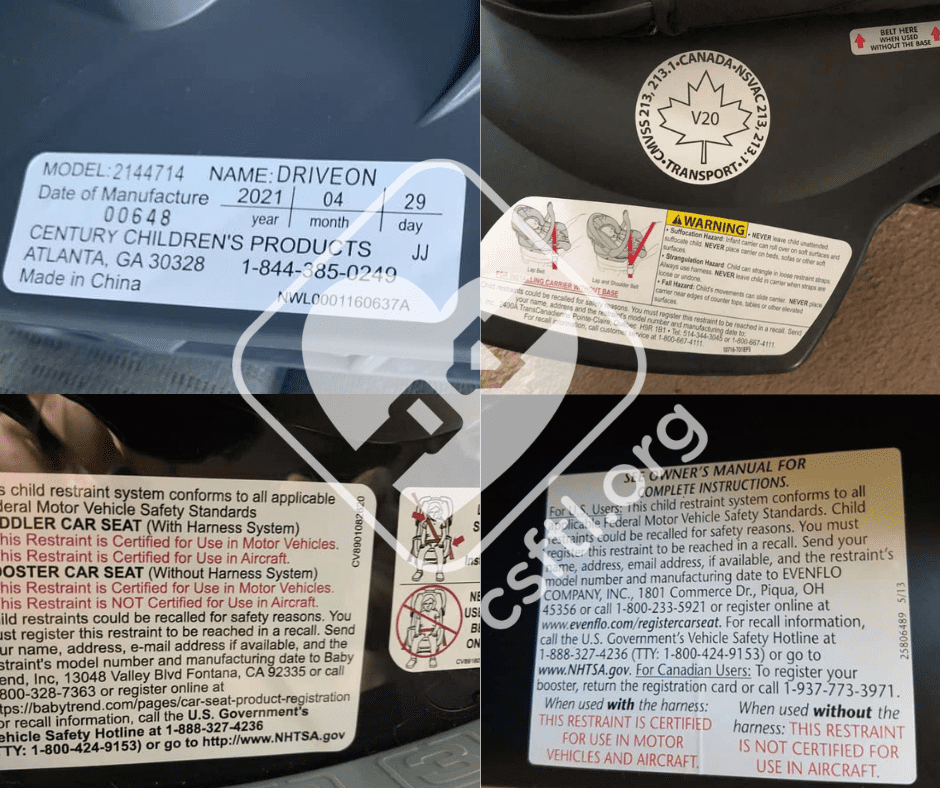
Examples of required labels/stickers that indicate a seat is safe and legal to use.
A car seat that has passed FMVSS213 and is legal for sale and use in the United States will include some very specific labels.
Counterfeit seats will not have these labels.
- A white label with red and black writing indicating the seat meets those federal standards.
- Canadian car seats will have a maple leaf sticker.
- Date of manufacture label. This label includes the model name, serial number, and date of manufacture on it. The location of this information varies by seat and manufacturer, but the information will always be on the seat.
- Labels showing and explaining the usage of the seat. Recline angle information labels, belt guide instructions, lower anchor weight limits, and other key information will be on this label. Actual placement of this label varies by car seat and manufacturer.
More about that Date of Manufacture Label
FMVSS213 states that all car seats sold in the United States car seats must have the following:
- Model name or number
- Manufacturer’s name, address, and telephone number
- The statement: “Manufactured In” followed by the month and year of manufacture (or year-month-day)
- Place of manufacture (City and State, or foreign country)
- The following statement(s) must be on one or more labels:
- “This child restraint system conforms to all applicable Federal motor vehicle safety standards.”
- If the child restraint has met additional requirements for use in aircraft, “This Restraint is Certified for Use in Motor Vehicles and Aircraft” or if not, “This Restraint is Not Certified for Use in Aircraft” must be in red print following the certification statement in the previous bullet.
- Minimum and maximum weight and height requirements labeled in English imperial (lbs. and in. or) or (lbs. and “) and metric (kg and cm) units
- The statement: “For recall information, call the U.S. Government’s Vehicle Safety Hotline at 1-888-327-4236 (TTY: 1-800-424-9153), or go to http://www.NHTSA.gov.”
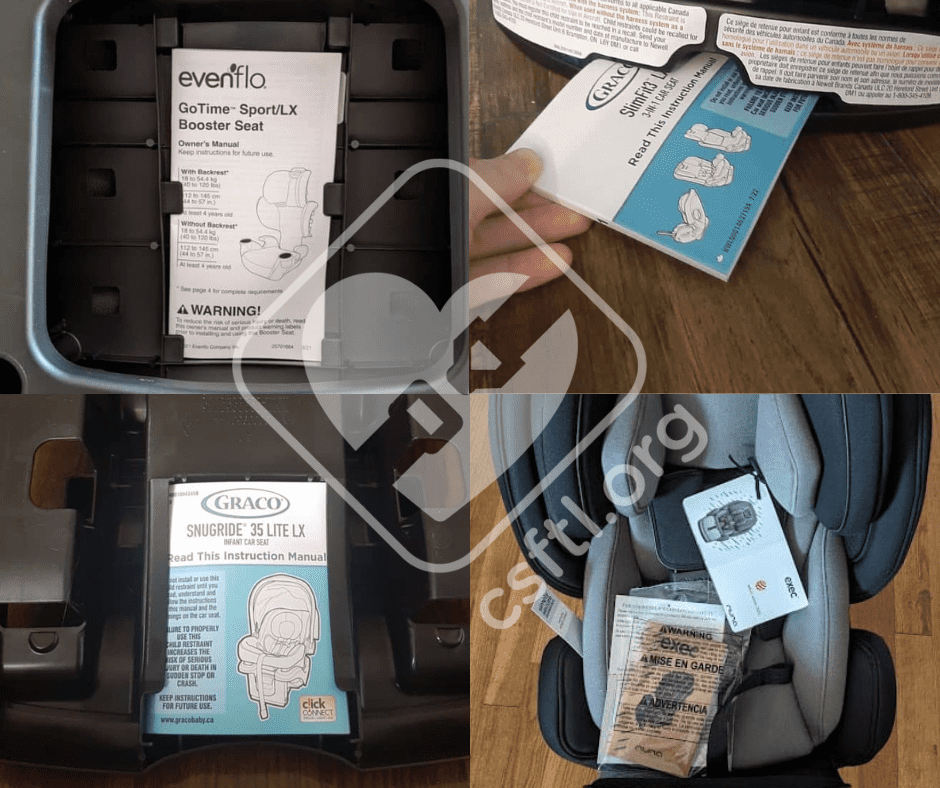
Examples of where car seat manuals and registration cards can be found (and stored) on new car seats.
#2: No Registration Card or Manual
Counterfeit car seats typically do not include a manual or a registration card.
Legitimate car seats will include a manual and a registration card. The manual may arrive in a stored location, the manual may be sitting directly on the seat when the box is opened. The manual should be clearly written and include the manufacturer’s logo and contact information. For families in the United States, that manual should be in English and Spanish, for Canadian families, the manual should be in English and French.
#3: The Car Seat was not Purchased from a Reputable Retailer
We always recommend purchasing a car seat from an authorized retailer. If you don’t want to purchase directly from the retailer (because we get it – you can find better deals in other places), you can check the manufacturer’s websites for a list of their authorized retailers or use the charts below as a guide.
Always make your car seat purchases from a trusted retailer. We do not suggest purchasing from liquidators or other resale websites/businesses.
#4: Missing a Five Point Harness

A Graco Snugride 35 rear facing infant car seat with a 5-point harness compared to a counterfeit Chinese car seat from Amazon that features a harness resembling a stroller’s.
It’s a common misconception that car seats sold in the United States are legally required to have to have a chest clip.
They do not – however, almost every rear facing and forward facing harnessed car seat on the market in the United States includes a chest clip.
If you see a harnessed car seat being sold in the United States without a chest clip, it is likely a counterfeit (or foreign) car seat, which would not be legal to use in the United States. The AAP’s 2023 list of available car seats is a great way to verify if the seat you’re considering is approved for use in the United States.
Counterfeit Car Seats Outside the United States
Unfortunately, these counterfeit car seats are not just limited to the United States, we’re seeing them in other countries as well. Counterfeit European seats are a larger issue in non-EU countries that allow the use European car seats. These countries include Eastern European countries, South Africa, and parts of Asia. If you’re purchasing a car seat in any of these areas, check the seat’s label before making a purchase and ask the company selling the seat to provide homologation evidence for a seat if you’re unsure.
Car seats that are sold in Europe must have labels that contain a few required pieces of information, including the regulations under which the seat was approved (as of April 2023 both ECE 44/04 and ECE 129 are legal for use throughout Europe), a circle with an “E” plus a number indicating the country where the approval was obtained, the height/weight limits for the seat, the seat’s approval number, and some other items of information including the car seat’s serial number.
This label may appear legitimate, but on closer inspection, a few key things indicate that the car seat isn’t. “Universal” is spelled wrong, there is no such thing as “Class” under ECE 129 standards, and it’s missing its serial number. If you didn’t look closely, however, it would be very easy to mistake this for a legitimate label.
Common Counterfeit Car Seats
Three of the most common counterfeit car seats we encounter when working with parents and caregivers are fake Doonas, fake infant car seats, and Chinese “booster” seats.
Counterfeit Doona Rear Facing Only Car Seats

A counterfeit car seat listing on Temu that resembles the Doona stroller car seat from Simple Parenting.
Doona car seats are one of the most popular counterfeit car seat models. Unless the seat is sold by one of Doona’s authorized retailers, the seat is likely not safe or legal to use. These counterfeit car seats have the same red flags listed above.
Counterfeit Rear Facing Only Seats
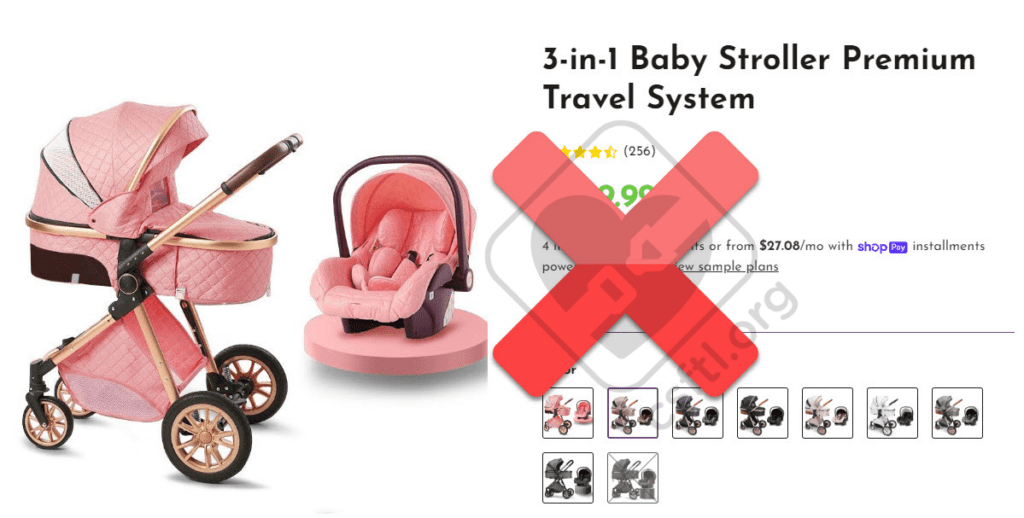
A counterfeit rear facing only car seat set marketed as a luxury travel system with a “baby seat”.
These counterfeit rear facing only car seats are often sold in a set marketed as a “3-in-1 Bassinet Travel System” or something similar. The travel baby seat resembles a car seat but lacks the necessary safety test and subsequent labeling required of a federally approved car seat.
Harness “Seats”
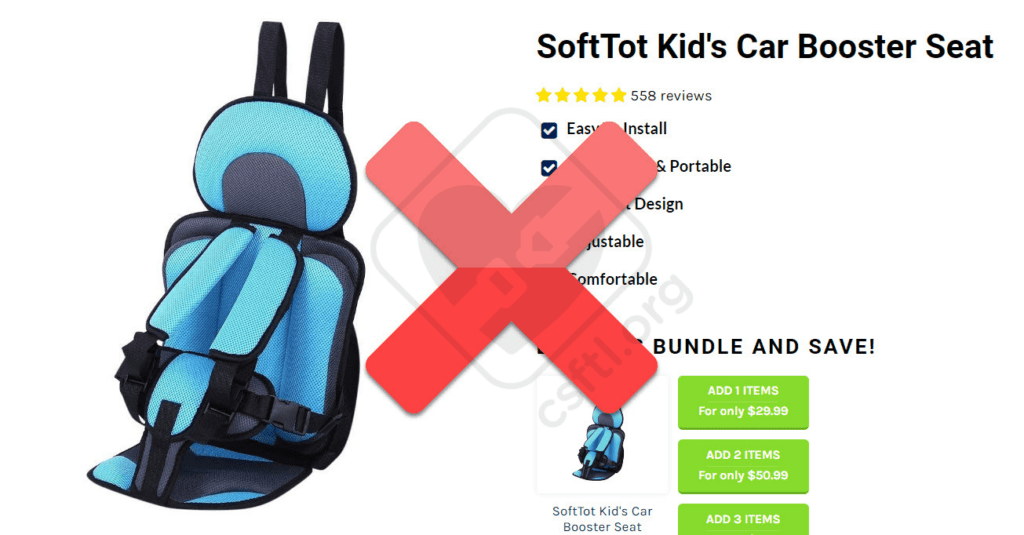
A car seat product listing with a counterfeit Chinese “booster seat.”
These counterfeit car seats are not new and we see them make their rounds in our Facebook group quite often. These, at first glance, look like they could be a slim and lightweight travel option for families. However, at a deeper look, you can see based on pictures and the websites these products are listed on, these harnesses lack the federally-required labels. Even more critical is that these devices don’t pass any safety testing. These seats were part of a recall.
Britax put these harnesses to the test in a UK study, and the crash test results were pretty scary.
Confirming your Child’s Car Seat is Legitimate
If your child’s car seat is missing the labels, manual, or registration card that we mentioned above, here are a few additional ways to confirm that the car seat is legal and safe for use in the United States:
- Find the label with the car seat manufacturer’s name, address, and phone number and contact them about your seat directly
- Find a CPST near you for an in-person check
- Post in our Facebook group for advice
If you have a Counterfeit Car Seat
If this article has helped you discover that your child’s car seat is indeed counterfeit, we are very glad that you read this article. Purchase a legitimate car seat from an approved retailer or directly from the manufacturer, stop using the counterfeit car seat and dispose of it. If you need help finding the right seat to purchase, visit our Facebook group for advice or start with our list of recommended car seats.
